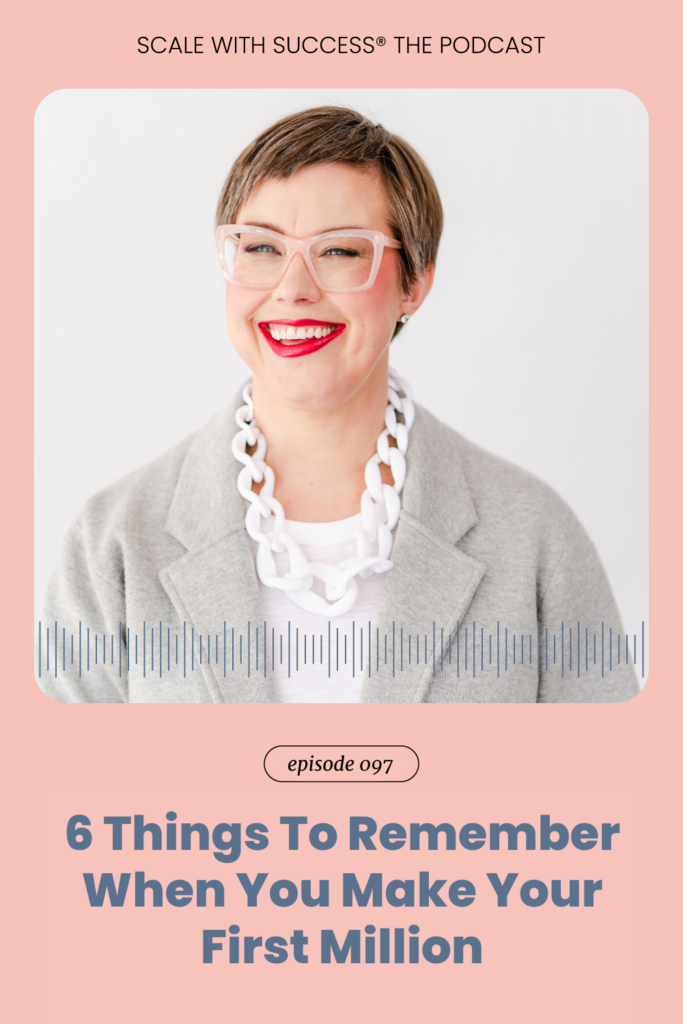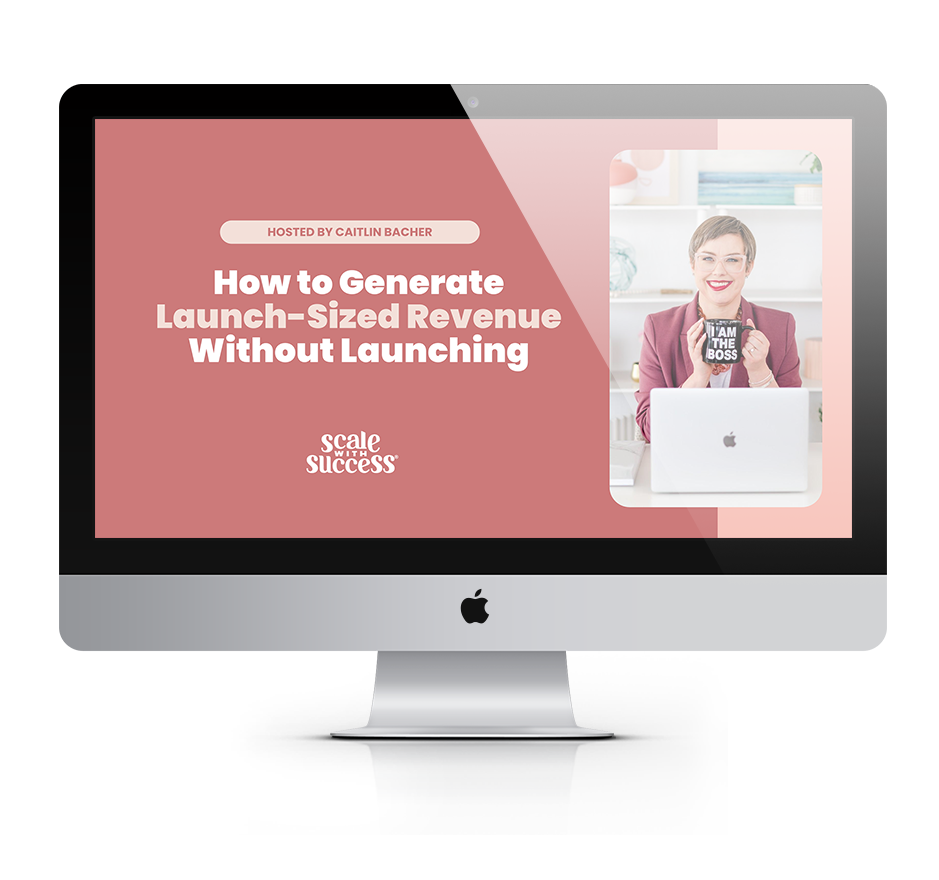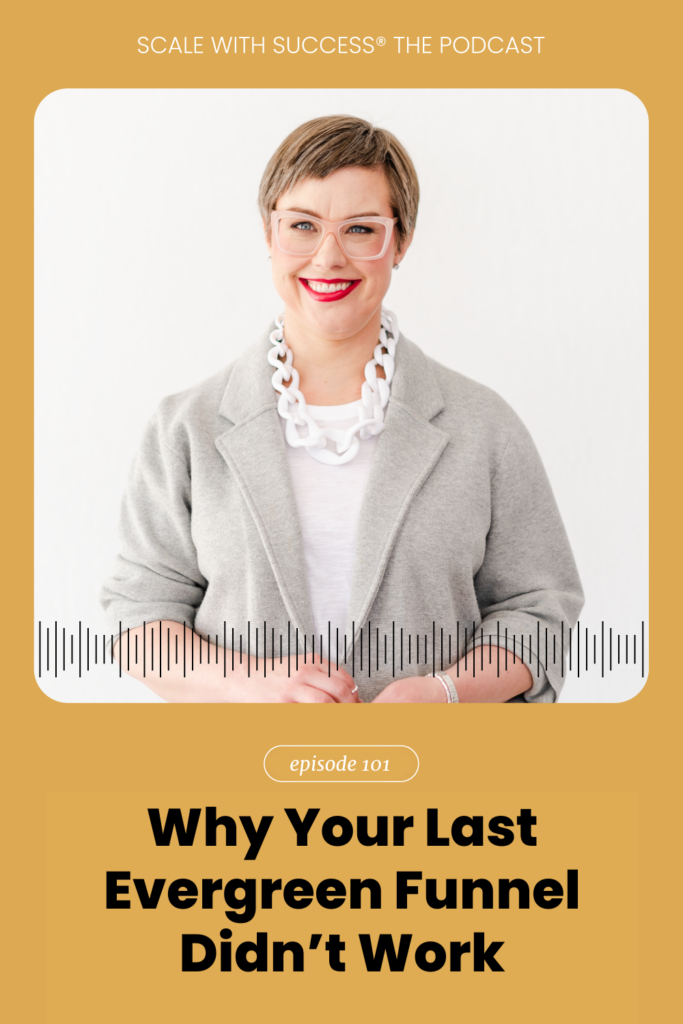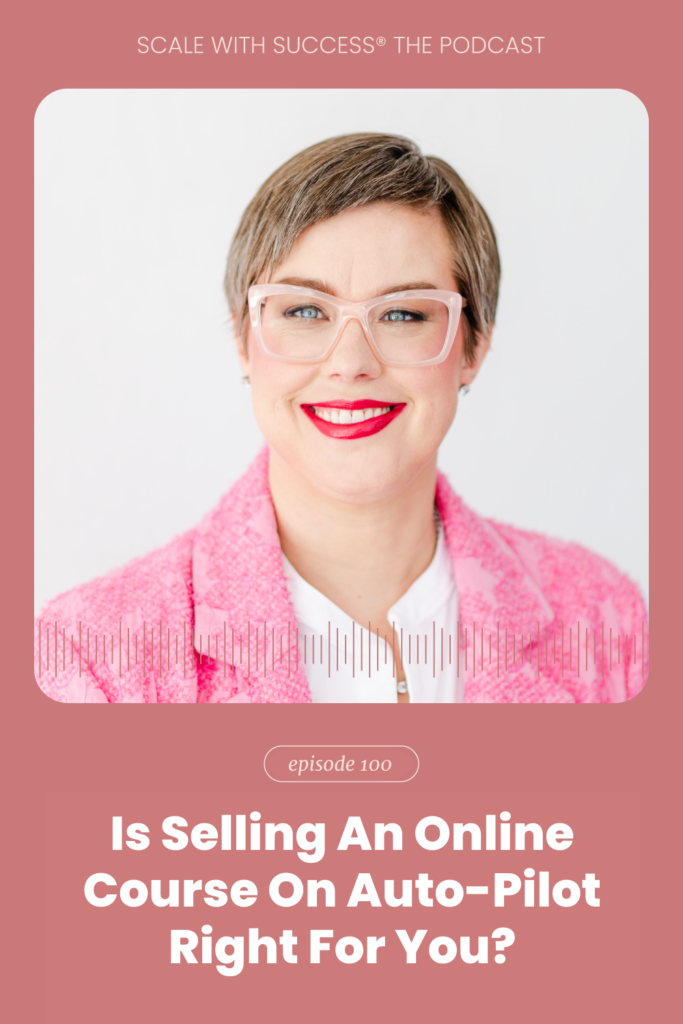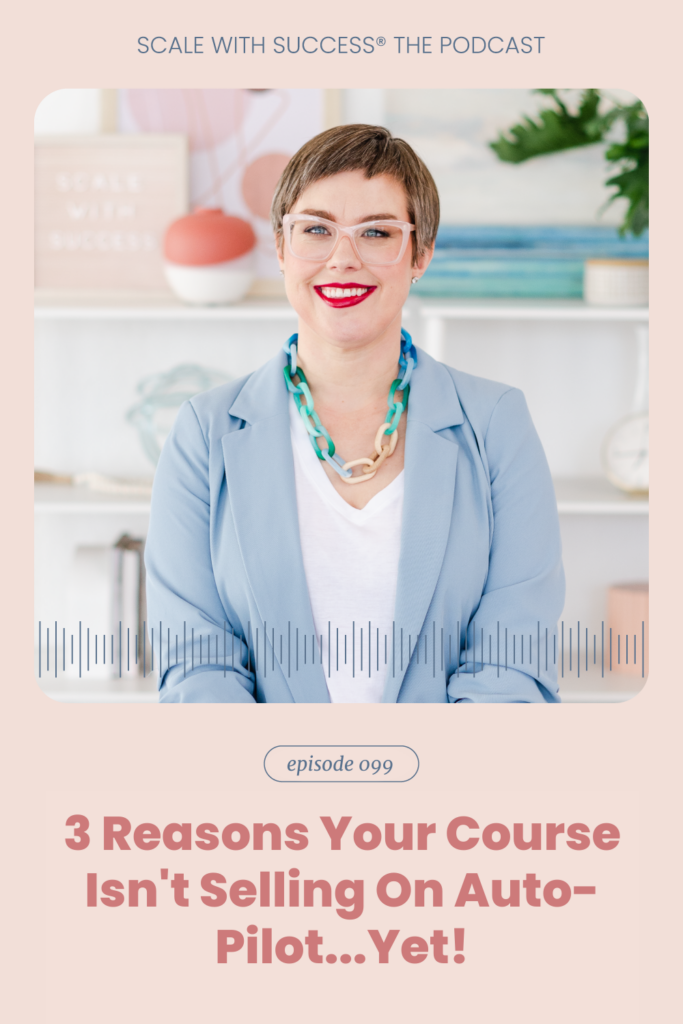If you have dreams about one day reaching your first million dollar year, then you are going to want to listen to this episode all the way to the end and then save it for later.
I can’t go back in time to tell myself these six pieces of advice, so instead I’ll share them with all of you so that when you hit your first million dollars, you’ll be one step ahead.
Let’s get started.
My name is Caitlin Bacher, CEO of Scale With Success®, and I’m on a mission to help course creators all over the world grow their business in a way that is profitable and scalable. I’m sharing revealing insights about what it really takes to scale an online course business to millions of dollars per year. Join me here to discover the tough decisions I’ve had to make, the biggest failures I’ve had to bounce back from, and the learnings that emerged every step of the way. I’m so grateful that I have the chance to tell you everything right here on Scale With Success®: The Podcast. Let’s get started.
Today I’m sharing 6 things to remember when you reach your very first million dollar year.
I’ll never forget the day I crossed the million dollar mark in annual revenue, reaching a goal I set for myself 13 months prior.
Let me be clear that I invested heavily in getting the support I needed to make it happen.
Coaches, courses, you name it, I invested in it, because I wanted to ensure I had the best chance of success.
This was not a fluke, it was incredibly intentional.
I was tired of figuring everything out on my own, and I knew I could move much faster if I could learn from others.
Until then, I took great pride in feeling like I could do everything on my own, but eventually I realized that this was the slowest, least profitable, most painful way to grow a business.
I was sick of wasting time and knew that I needed to get over myself and get some help.
Asking for help as we grow our business is kind of a funny thing.
Most of us get into business because we love the feeling of independence that comes with being your own boss and clearing your own path forward.
But ignorance is bliss and depending on how stubborn you may be, it can take a while before you realize that your knees are bloody, you can’t see straight, and you are moving 10 times slower than you could be moving if you started doing the right things.
You don’t know what you don’t know, which is why the more your business grows, the more you need to learn.
This can feel weird, and it’s tempting to mistake your realization that you actually know nothing for incompetence, but the reverse is actually true.
You will never find someone who is more confident than someone who is completely incompetent.
So as we grow, it’s important to look back and see how far you’ve come.
I know when you’re in the thick of it may not feel very far at all, which is why I am going to share these 6 essential things to remember right now.
I, too, am in the thick of it and need these reminders just as much as you.
Number 1: This is an extremely rare occurrence.
So only 36% of women are small business owners, and only 2% of women-owned businesses make over 1 million dollars.
Even less are women of color.
Men are 350% more likely to cross the million dollar mark.
This is, and by this is, I mean making a million dollars in your business, an extremely rare occurrence.
And I think a lot of times as online course creators, we get caught up in what’s happening on social media, and depending on who it is that we’re following online, it can seem that just about everyone is making millions and millions of dollars per year, but this is not reality.
In reality, only 2% of women-owned businesses make over a million dollars per year.
And I say this for those of you that are setting the intention to generate a million dollars this year in your business, do not get caught up in comparing yourself to others.
This is a rare occurrence, and just because it may seem that everyone else is doing it doesn’t mean that it’s actually happening.
Number 2: Not everybody hates you.
Now listen to this, especially for all of those people pleasers that are in the audience right now.
Being a CEO is hard, and being a CEO who is also the face of your brand is even harder.
You got into this business to help people, and when someone is unhappy, whether it’s an audience member, a client, or someone on your team, it can really sting.
It’s easy to fall into the trap of maximizing the voices of those who are upset and minimizing those who are loving everything you’re doing.
But the truth is that there is, has been, and always will be someone who is happy with you and someone who is unhappy with you.
So assigning your value based on the opinions of others is a losing game.
If you shift your attention to someone who is happy with you and then give yourself permission to have value and pat yourself on the back, just know that there is someone standing right next to them who is unhappy.
You’re just not paying attention to them.
So you’re choosing to assign yourself value based on where your attention is, which is always changing.
So one of the most important things that you need to understand, especially when it comes to scaling your business past the million dollar mark, is that your value as a human is not dependent on your achievements.
It’s not dependent on the success or failure of your business because at any given moment, your business is both succeeding and failing, just like someone at any given moment is unhappy with you and someone is happy.
A lot of times, it’s easy to fall into the trap of really blurring the lines between where your business starts and where you end.
And they are two separate things. They are two separate entities.
And I get it.
We are very passionate about our business.
We have invested a lot in our businesses, time, energy, money, blood, sweat, tears, all of that.
And so I understand just how easy it is to feel like you are your business.
But if you are doing that, then you’re going to set yourself up for really being on an emotional roller coaster because every time someone’s happy with you, you’re going to feel great, and every time someone’s unhappy with you, you’re going to feel terrible.
If your business is doing great, you’ll feel great.
If your business is not doing so well, then you’re going to feel bad.
That’s not sustainable, and it’s really important that we don’t maximize what’s not working and minimize what is working, because again, at any given moment, something both is working and is not working inside of your business.
So your value, your worth as a human being comes from within you.
It’s not dependent on anything else.
And just know that in those moments where it feels like maybe everyone on your team hates you or everyone in your audience hates you, or all of your clients hate you, just know that you are not alone and that I guarantee there is another CEO, many CEOs out there right now that are having the same feelings.
And just because you’re having those feelings doesn’t mean that, that is actually reality.
The feelings are real, but it’s literally impossible for absolutely everyone to hate you.
And if you let yourself feel that way, you’re going to notice some contraction taking place because you’ve gotten to a million dollars, that’s great, that’s amazing, that’s incredible.
But if you become overly focused on other people’s perceptions of you and other people’s perceptions of the actions that you are taking in your business, then you’re going to start to retreat, you’re going to contract, and you’re going to hide.
And that’s why so many entrepreneurs who hit the million dollar mark end up going back the very next year.
It has nothing to do with sales, it has nothing to do with marketing.
It’s simply because you have let all of those feelings and emotions get to you.
Every feeling is valid, your emotions are real, but just know that as a CEO, it’s your responsibility to process your emotions, process your feelings, so that you can move forward.
Number 3: Leadership looks different for everyone.
It’s okay to be yourself.
When I first started building my team, I did what most people do and I modeled my leadership style off of my coach.
Now, it’s one thing to take things like templates on how to run a meeting or templates on how to create an annual plan.
It’s one thing to take those and implement in your business, but it’s quite another to take the literal leadership style of someone else who is not you and feel like that is the only way to lead.
The greatest leaders are able to tap into their own unique strengths and use those in order to lead their team forward.
Here’s an example.
If you are an introvert like me, I am extremely introverted, I need so much alone time. My husband calls me a hermit, and honestly, I am a bit of a hermit.
Now, my job requires me to interact with both small and large groups of people, but after I do that, it’s really important for me to take that time to retreat and rest.
So it would not make sense for me to base my leadership style on someone who is extroverted, who gets energy from interacting with other people.
Because many of the activities that they would do in their day-to-day business might work great for them, but it’s not going to work for me.
It’s going to drain me, and it’s going to leave me in a place where I feel like I can’t show up for my own audience to do what I need to do as a CEO and attract new people and spread brand awareness.
I’m not able to do that if I’m not effectively managing my own energy. And it’s nobody else’s fault.
Your coach can give you all the ideas in the world, but it’s up to you to figure out what you want to take and what you want to leave.
And the other thing to point out is even as you grow your business and as you start to hire leaders within your own team, people that are managers, that are directors, they are going to have a different leadership style than you, and so it’s unfair to make character judgments about what they’re doing just because it’s not something that you would do.
Now, I’m not talking about things that are related to core values.
Your company has a set of core values that you use as a filter to make all decisions, but the way those decisions are made looks differently to everyone, and if you are not able to honor your own unique leadership style, then you’re not going to be able to do that for anyone else on your team that you hire as a leader.
If you can’t trust yourself, how are you going to be able to trust anyone else?
Number 4: Do more of what works, but never stop experimenting.
It’s very easy to become set in your ways about doing something.
Maybe you have a podcast and you only do the podcast once per week, and you’ve been doing
it that way for years.
Maybe you have a YouTube show and you don’t have a podcast, and you’re just doing this YouTube video show every single week, week after week.
Maybe you only post static images on Instagram, and you’ve always done it that way, and so you’re just going to keep doing it that way.
This approach to business does not work because things are always changing.
Things are always shifting.
So yes, it’s important to measure your results and do more of what’s working, but you always want to set aside a smaller amount of time, energy, money, resources to experiment with new things.
So one example is when you’re creating content for either advertising or social media. When you are creating that creative content, your goal should always be to be able to surpass the results of what has been done previously.
Just because something is working now doesn’t mean that it will always work.
So you need to make sure that you’re setting aside a small amount of resources to continue to experiment so that you have something in your back pocket that you can pull out if the main thing that you’ve been doing starts to decrease in effectiveness.
And I know this is hard with small businesses because a lot of times our resources are so limited, which is why it’s so important that when you’re building a business to really set things up so that you can generate consistent revenue, so that you always have money coming in, so that your cash flow is good, so that setting aside a small amount of those resources is a real possibility.
You are able to do that.
One of the ways that you can do that is by automating your sales process.
If you’re automating your sales process, if you’re not caught up in launching after launching after launch, if you’re not caught up in that, then it frees up your time.
You are not focused on selling.
You’re focused on what you need to do to attract new people and what you need to do to serve those people.
And because your business is generating consistent revenue and because you’re able to build momentum and you’re not doing this wild stopping momentum and then starting momentum the way that most people doing the launch model experience, you are able to increase your revenue month after month so that you can really start to reinvest, so that those things that you need to maintain, the things that are working, you can begin to hire people to do those things, to keep the status quo, and then you can divert your energy into experimenting and trying out some new things, so that, one way to put it, you’re not caught with your pants down.
Number 5: Everything won’t disappear tomorrow.
One of the biggest fears that I hear from clients who have crossed that million dollar mark is that they have this internal fear that everything is going to disappear the next day.
It almost feels for some of them like their success is a fluke.
But one thing I can assure you of is that generating over one million dollars in one year is not a fluke.
That took a lot of intention and a lot of strategy, and for those course creators that are really looking to expand upon their success, they’re always looking for that next thing that’s going to create more sustainability, more predictability, more consistency in their business.
And for many course creators, that looks like quitting launching and moving into something more automated, moving into a sales process that is hands free so that you as a CEO can focus on what you do best and free yourself from the pain of having to launch all the time and free yourself from the inconsistent up and down roller coaster revenue that comes along with that.
Number 6: Never let a big loss go to waste.
As long as you’re growing, you will continue to experience mistakes and failures – some bigger than others. When those L’s happen, learn from them.
What caused it? What can be done to prevent it from happening again? What can you do to minimize risk if it does happen again?
Ultimately, the failure or success of your company is on you and it’s your job to create a culture of radical acceptance and curiosity so your team ISN’T afraid to take calculated risks because that’s where the magic is. A team afraid to take a chance or stick their head out for an initiative they believe in is completely useless because without risk there is no reward.
It’s your job to foster a sense of radical acceptance when the loss happens – meaning you don’t try to cover it up and pretend it never happened or find someone to blame. Celebrate the risk that was taken and remind everyone that we at this company, we never let a big loss go to waste.
I appreciate you being here and join me next week for another episode of Scale With Success® The Podcast.
Are you sick and tired of launching and looking for a proven method to generate consistent revenue from your online course on auto-pilot?
Sign up for my free masterclass, “How To Generate Launch-Sized Revenue Without Launching” and I’ll show you how our clients are making MORE money in LESS time than they ever did while launching.
If making sales everyday in a way that is completely automated and doesn’t require paid advertising sounds good to you, then click the link around this episode and sign up for my free masterclass today.
Today’s episode is brought to you by Scale With Success® Accelerator — an online course designed to help you generate launch-sized revenue without lanching. If you want to learn MORE about our proven method for success, click here to watch my free masterclass. See you in there!



